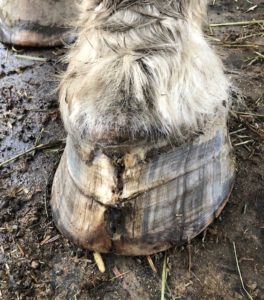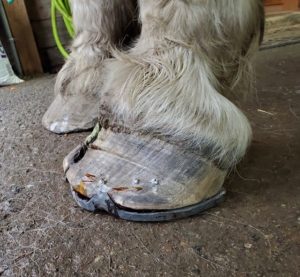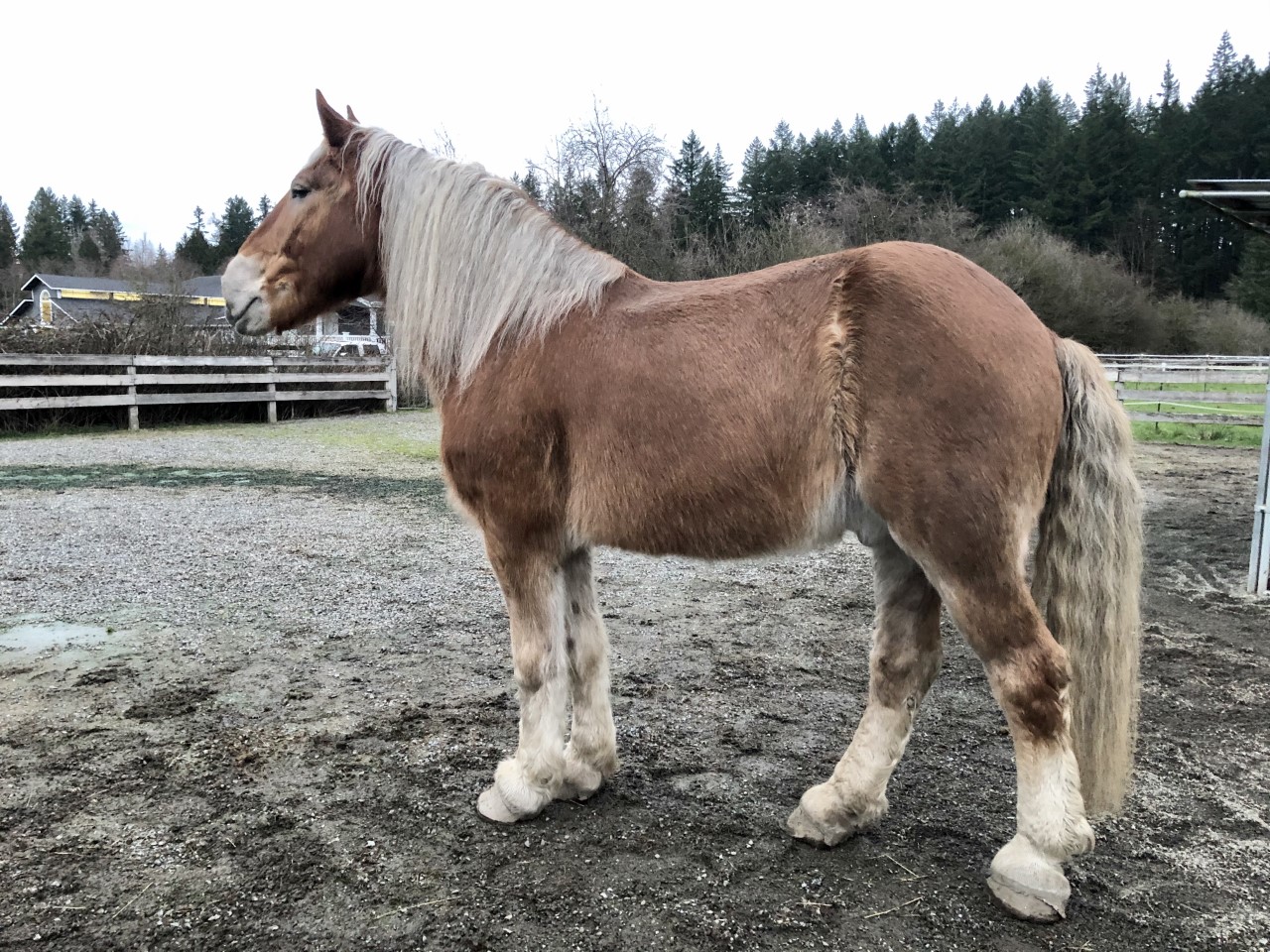We’ve been fighting a losing battle with Slim’s foot. Every time we think we’re making progress in getting him healed, another abscess pops up and the crack in his foot becomes even bigger. Because this has been going on for such a long time, let me summarize the chain of events that has gotten us where we are today.
We had suspected that Slim dealt with recurring issues in his left front foot since his arrival at SAFE due to the appearance of his hoof wall. Rather than a nice, smooth, wall, the front (dorsal) part of Slim’s hoof was littered with cracks and ridges. Evidence that there was a chronic problem there. But Slim remained trouble-free for the first few months we had him. Then July rolled around, and he became acutely painful in that foot. Radiographs revealed a large abscess brewing and osteomyelitis, an infection in his coffin joint. A few days of wrapping his hoof and applying icthammol ointment helped bring the abscess to the surface, and the largest abscess I’ve ever seen eventually busted through his coronary band.
Slim was placed on long-term antibiotics and pain meds for the osteomyelitis. His foot was re-wrapped first daily to help draw the drainage out, and then we eventually got to phase out the bandages once things dried up. But it seemed like every time one abscess would clear, another would pop up in its place. He still remained on the antibiotics, and we played with the pain medication levels depending on what Slim would tell us. Some days he’d be as comfortable as could be so we’d back off the pain meds thinking we were making progress, but other days he’d start to limp again with another abscess brewing so we’d increase the meds a little. In October, Dr. Fleck came out to dremel a hole in Slim’s hoof wall to allow for more drainage. Once this hole was placed, Slim seemed much more comfortable. We were hopeful that this was going to be the answer to our problem. But alas, it was only a temporary solution.
Throughout all of this, a crack began to form. It started at the bottom of his foot where it meets the ground and slowly traveled upward. Eventually the abscesses near the coronary band started a crack up in that region that slowly traveled downward. All the cracking met at the middle at the dremeled hole to create one solid crack that spans the entire length of his hoof.
From the beginning of this whole foot dilemma, our vets at Rainland Farm Equine laid out our options in black and white. We could do surgery. Surgical debridement of the coffin bone to remove the infected area is a standard treatment for osteomyelitis. This option was not a great one for Slim because a horse undergoing this surgery needs to be good with having their feet held up for an extended period of time during surgery. Slim is not amenable to holding his foot up for long at all, even under sedation. They could lay him down under general anesthesia to do the surgery, but general anesthesia in draft horses is quite risky, not to mention expensive. We were told the other procedure to try would be putting a supportive shoe on him to keep the crack from being reinforced every time Slim takes a step. A shoe that holds the foot together would give it a chance to grow out normally. But again, Slim is not great for having his feet handled for lengthy periods of time, as would be required with shoeing. He would need to be sedated for each shoeing, and even then, there would be no guarantee that he’d allow us to get a shoe on in the first place. The only other option we had other than euthanasia was to try the conservative approach with medication and bandaging. This is the option we ended up taking.

Oftentimes, the conservative approach pays off and the horse recovers just fine without going to extreme measures. But this has not been the case with Slim. Medication and bandaging have improved the osteomyelitis a bit. His radiographs look better now than they did at the time of his last recheck in the fall. But it’s become clear that there’s no way this crack is going to heal without intervention.
And so, Slim had a group consult with Drs. Fleck and Lewis from Rainland Farm Equine Clinic and farrier, Lisa Fite. He was sedated, x‑rays were taken, another abscess was pared out of his sole, legs went flying, he was sedated again, and a special shoe was placed. It was a long endeavor but, with patience, Lisa was successful in getting the shoe on. We are now treating the solar defect daily with betadine until it heals, and we are continuing with the antibiotics and pain medication.

Slim’s new shoe!
We’ll have a recheck done on him in a couple of weeks. Hopefully at that time the vets will be able to see some progress. Everyone here is pulling for him, and he is definitely a favorite around the barn. He’s charismatic and loves attention, and it’s tough not to love that sweet, giant face. But we have to make sure that we’ll be able to keep him comfortable in the long run, because asking a horse to continue living life in pain isn’t fair–and it’s not what we’re about. Unfortunately if this treatment route doesn’t work, then we’re out of realistic options for him. An 1,800 pound draft horse needs sturdy feet to stand on. We haven’t given up hope, though. Stay tuned for a progress report in a couple of weeks.


